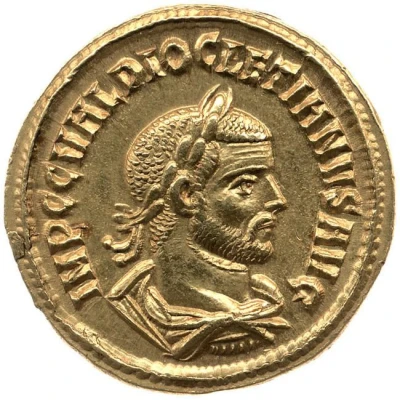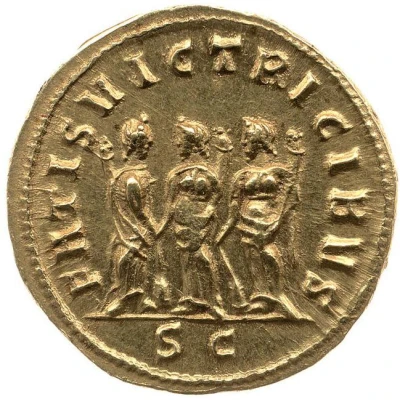


© Trustees of the British Museum
Aureus - Diocletianus FATIS VICTRICIBVS; Parcae
| Gold | 5.4 g | 21 mm |
| Issuer | Rome › Roman Empire (27 BC - 395 AD) |
|---|---|
| Emperor | Diocletian (Gaius Aurelius Valerius Diocletianus) (284-305) Maximian Herculius (Marcus Aurelius Valerius Maximianus) (286-305) |
| Type | Standard circulation coin |
| Years | 284-294 |
| Value | Aureus (25⁄2) |
| Currency | Antoninianus, Reform of Caracalla (AD 215 – 301) |
| Composition | Gold |
| Weight | 5.4 g |
| Diameter | 21 mm |
| Shape | Round (irregular) |
| Technique | Hammered |
| Orientation | Variable alignment ↺ |
| Demonetized | Yes |
| Updated | 2024-10-05 |
| Numista | N#306131 |
|---|---|
| Rarity index | 100% |
Reverse
The Parcae, draped, standing, clasping hands, holding three cornucopiae and two rudders.
Script: Latin
Lettering:
FATIS VICTRICIBVS
-/-//SC
Unabridged legend: Fatis Victricibus
Translation: To the victorious fates
Comment
Mass varies: 5.34–5.43 g;Example of this type:
Trustees of the British Museum
Source:
Online Coins of the Roman Empire (OCRE)
Interesting fact
One interesting fact about the Aureus - Diocletianus (FATIS VICTRICIBVS; Parcae) coin is that it was issued during a time of significant economic and political change in the Roman Empire. The coin was minted during the reign of Diocletian, who introduced a number of economic reforms in an attempt to stabilize the empire's economy and address issues such as inflation and debasement of the currency. The coin's design, which features the goddess Fortuna on one side and the emperor Diocletian on the other, reflects the cultural and religious beliefs of the time. Additionally, the fact that the coin was made of gold, a valuable and durable metal, speaks to the wealth and power of the Roman Empire during this period.